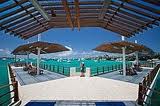 Center of the archipelago is Santa Cruz island, where the volcanic activity has long ceased, and now this island is the focal point for the Galapagos. Santa Cruz has the largest human population any of the few islands that people inhabit. The population is mostly centered in the port city of Puerto Ayora. Center of the archipelago is Santa Cruz island, where the volcanic activity has long ceased, and now this island is the focal point for the Galapagos. Santa Cruz has the largest human population any of the few islands that people inhabit. The population is mostly centered in the port city of Puerto Ayora.  On the south shore of Santa Cruz, Puerto Ayora is a pretty little oceanside community with many hotels, hostels, restaurants, dive shops, art galleries, and gift shops. There are a few ATM machines located by the main harbor, Academy Bay, and further east along Av Charles Darwin on the way to the Charles Darwin Center. On the south shore of Santa Cruz, Puerto Ayora is a pretty little oceanside community with many hotels, hostels, restaurants, dive shops, art galleries, and gift shops. There are a few ATM machines located by the main harbor, Academy Bay, and further east along Av Charles Darwin on the way to the Charles Darwin Center.
Puerto Ayora is where the administrative center of the Galapagos National Park and Charles Darwin Station are located. To get to Santa Cruz you must cross the canal of Itibaca on a ferry. The cost is about .80 cents. Then from the ferry you can take a taxi ($18) or a bus ($1.80) to Puerto Ayora, approximately a 40 minute journey across the island.
Below are quick links to the different areas on and around Santa Cruz Island.
The airport is located on Baltra Island. This was the site of a US Air Force Base during World War II. After the war the facilities were given to the government of Ecuador. Today the island continues as an official military base, but more importantly Baltra serves at the principle airport to the Galapagos Islands with daily flights to and from. Upon arrival passengers must show their passport, INGALA Visitor Control Card and pay their Galapagos Park Fees.
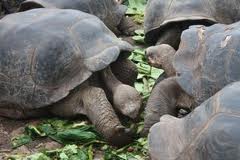 Charles Darwin Research Station, by visiting the facilities of the Darwin Station and National Park it is hoped that the visitors will begin to realize that not only scientists, but also professional administrators and park wardens must exert an enormous cost in an effort to maintain the islands ecosystems. The money goes to preserving the endangered species which exist on the islands and maintaining their natural state, so people may enjoy seeing them for many years to come. In the Charles Darwin Station you will see up close giant tortoises, featuring Lonesome George (the last survivor of the distinct Pinta subspecies). The Charles Darwin Research Station is also part of the Centro de Crianza Fausto Llerena which is the breeding center for the tortoises. Tortoises are raised here in the care of researchers and then when ready re-introduced into there natural environment. Charles Darwin Research Station, by visiting the facilities of the Darwin Station and National Park it is hoped that the visitors will begin to realize that not only scientists, but also professional administrators and park wardens must exert an enormous cost in an effort to maintain the islands ecosystems. The money goes to preserving the endangered species which exist on the islands and maintaining their natural state, so people may enjoy seeing them for many years to come. In the Charles Darwin Station you will see up close giant tortoises, featuring Lonesome George (the last survivor of the distinct Pinta subspecies). The Charles Darwin Research Station is also part of the Centro de Crianza Fausto Llerena which is the breeding center for the tortoises. Tortoises are raised here in the care of researchers and then when ready re-introduced into there natural environment.
Attractions: Giant Tortoises Activities: Walking, Education
Landing: dry
Tortuga Bay is another destinations to visit on your own on Santa Cruz with baby powder white sand, magic blue waters, marine iguanas, and sometimes flamingos. It is only 2.5 Km from Puerto Ayora on a nice brick path (about 30-45 minutes walking). There are NO facilities here. So bring drinking water and possibly a snack.
Las Grietas is located very close to Puerto Ayora, west of Academy Bay. You will need to take a water taxi to the trail head. From there you can take the trail directly to Las Grietas. You should where shoes and flip flops are Not recommended; the trail is very rocky and uneven.
In Las Grietas you can appreciate two layers of water very clearly. The surface water is fresh water that filters down from the top before reaching the ravine and the bottom water is salt water entering from the sea. The mixture of these two waters is called brackish water. This a great spot for photography and swimming
There are Lava Tubes at El Mirador (3 km from Pto. Ayora) where you can go into the earth at one place and come out 30 minutes later at another place.
Intact stands of vegetation zones, including dense scalesia forest and miconia, are some of the homes of unique Galapagos wildlife. The archipelago's most accessible population of giant tortoises can be found in this region of the Highlands. There are some of some 85 species of birds here, including nine Darwin's finches, rarities such as Galapagos rails, breeding dar-rumped petrels, and many other vagrant species.
 The trail to the highlands leaves Bellavista and passes through the agricultural zone and then, near the National Park boundary, the Miconia zone and the "pampa" or zone of low vegetation typical of the high areas of Galapagos. With clear weather (unpredictable) this area affords beautiful scenes of rolling hills and extinct volcanic cones covered with grass and lush greenery all rear round. Highlands feature giant tortoises, vermilion flycatchers, woodpecker finches, Galapagos rails and short eared owls. The trail to the highlands leaves Bellavista and passes through the agricultural zone and then, near the National Park boundary, the Miconia zone and the "pampa" or zone of low vegetation typical of the high areas of Galapagos. With clear weather (unpredictable) this area affords beautiful scenes of rolling hills and extinct volcanic cones covered with grass and lush greenery all rear round. Highlands feature giant tortoises, vermilion flycatchers, woodpecker finches, Galapagos rails and short eared owls.
Attractions: Wild Tortoises, Lava Tunnels Activities: Hiking
Landing: Dry

El Chato is an amazing opportunity to see the magnificent giant land tortoise in its natural habitat, having just seen the tortoise in the breading program in the station, you can now see them bathing and eating in the wild (depending on the season). This area is vegetated with transition zone vegetation and is located in the humid zone of the highlands of Santa Cruz. The walk to the reserve is one of the best places to observe ground birds, tree and ground finches, the vermillion flycatcher, cattle egrets and occasionally galapagos rails.
Attractions: Giant Tortoises, Finches Activities: Walking, bird watching
Landing: dry
Rancho Primicia is another giant tortoise reserve on private property in the Galapagos. The ranch is located against national park lands. The tortoises migrate here in search of cooler shaded area, water holes, and places to lay their eggs. Here you will have the opportunity to get up close to these incredible reptiles. Primicia is an excellent opportunity take some amazing photos of these gentle giants.
Attractions: Giant Tortoises, Finches Activities: Photography, Walking, tortoise watching
Landing: dry
Black Turtle Cove (Caleta Tortuga Negra) is one of the impressive Galapagos marine sites, consists of a deep maze of sea water inlets among the Mangrove trees.
The tranquil lagoon of Caleta Tortuga supports golden and spotted eagle rays, small sharks, and sea turtles resting and sometimes mating. You will find birds like herons, wader, Blue Footed Boobies, Pelicans, and Brown Nottys.
Attractions: Sharks, rays, sea turtles, sea birds Activities: Panga ride
Landing: none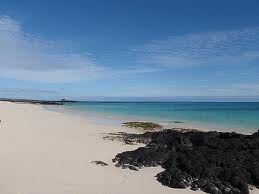
On Las Bachas Beach the sand is made of decomposed coral. This makes a soft, white sand which is ideal for sea turtles to make their nest in. You will find a small lagoon here were you could see flamingos, herons, and other birds feeding. Las Bachas is good for snorkeling, swimming, or just walking along this pristine place.
After WWII, US military barges were beached and abandoned here. The locals referred to the beach as the barges
beach, eventually the became "spangishised" into “Bachas”. This is a beautiful beach where you can relax and take in the wonderful world of the Galapagos.
 On the north shore of Santa Cruz is Cerro Dragon. This is one of the best places in the islands to see the land iguana. Here you will trek inland to see the large Land Iguanas of the Galapagos. You will also see finches, warblers, and mockingbirds. There is a saltwater lagoon where lucky visitors may see Pintail Ducks or Flamingos. On the north shore of Santa Cruz is Cerro Dragon. This is one of the best places in the islands to see the land iguana. Here you will trek inland to see the large Land Iguanas of the Galapagos. You will also see finches, warblers, and mockingbirds. There is a saltwater lagoon where lucky visitors may see Pintail Ducks or Flamingos.
Further inland along the trail there is a beautiful view of the bay and the western islands of the Galapagos.
Snorkeling or swimming is possible from the beach by the landing site.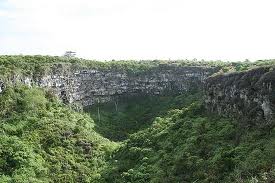
Los Gemelos is located in the Santa Cruz highlands, Los Gemelos (“the Twins”) refers to two large sinkholes which were formed by collapsing underground lava tunnels. The big attraction here is the Scalasia forest. Scalasia is a sort of tree endemic to Galapagos. Many endemic and native species call it home. Los Gemelos is the best place in Galapagos to see the dazzling, elusive Vermillion Flycatcher. Darwin finches are also commonly sighted there. There are hiking opportunities here; the trail conditions can be varied and you should use caution.
Attractions: Scalesia Forest, Pit Craters, breath taking views, Woodpecker Finch, Cuckoo Bird, short eared owl.
Activities: Hiking (short)
Landing: dry
Garrapatero Beach is a beautiful sandy beach surround by mangroves on the northern side of Santa Cruz island. There is a fresh water lake inland from the beach which is the home to flamingos, herons, and other shore birds. The turquoise waters provide a spectacular beach where you can swim and snorkel. You may encounter the Sally Lightfood crabs, marine iguanas, Blue Foote Boobies, and Bahama Ducks.
Attractions: White sand beach, flamingos, herons, grebes, and stilts
Activities: Swimming, snorkeling
Landing: dry
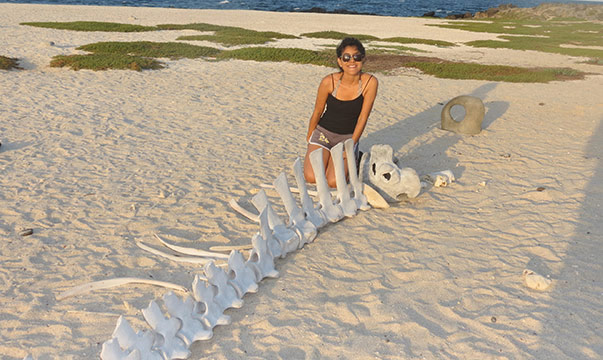 Mosquera is a small, thin island located between North Seymour and Baltra islands. It was created by a geological uplift. The island looks flat in comparison to the conical shape of the volcanically formed islands. This island consists of a long narrow stretch of white sand beach with rocks, and tide pools. An ideal location to relax and take in some beach time. You can snorkel, take a peaceful walk, or take pictures of the Boobies, Brown Pelicans, and the largest population of seal lions. Mosquera is a small, thin island located between North Seymour and Baltra islands. It was created by a geological uplift. The island looks flat in comparison to the conical shape of the volcanically formed islands. This island consists of a long narrow stretch of white sand beach with rocks, and tide pools. An ideal location to relax and take in some beach time. You can snorkel, take a peaceful walk, or take pictures of the Boobies, Brown Pelicans, and the largest population of seal lions.
Attractions: Sea Lions, sea birds
Activities: hike, Landing: wet
Whale Bay or Bahía Ballen is located on the western coastof Santa Cruz island near the base  of Dragon Hill. It is a semicircle beach which is green in color due to the high volume of olivine crystals in the sand. There is also a historical relevance to this location. A small community lived in this area around 1846, collecting lichen (Rosella
Tictoria), which is used in the textile industry. The trail leads guests to an old water hole used by the former settlers. There are also
boobies, land birds and beautiful views of the northwest side of Santa Cruz Island. Several activities are possible at Whale Bay after the trek such as snorkeling or a panga ride along the shoreline. of Dragon Hill. It is a semicircle beach which is green in color due to the high volume of olivine crystals in the sand. There is also a historical relevance to this location. A small community lived in this area around 1846, collecting lichen (Rosella
Tictoria), which is used in the textile industry. The trail leads guests to an old water hole used by the former settlers. There are also
boobies, land birds and beautiful views of the northwest side of Santa Cruz Island. Several activities are possible at Whale Bay after the trek such as snorkeling or a panga ride along the shoreline.
Attractions: Green sand beach, fur seals, Marine Iguanas, Galapagos Hawk, Giant Tortoises
Activities: short hike
Landing: wet
Punta Carrión is located on the Northeast tip of Santa Cruz island. The ships will navigate around this point which will you provide opportunities to see various sea birds nesting on the rock cliffs. Carrion Point creates a sheltered lagoon with beautiful, turquoise water. During this visit you may be able to snorkel and see a variety of fish, rays and perhaps the harmless white-tip reef sharks. The point is on the north coast of Santa Cruz Island.
Attractions: Marine life, white tip reef sharks
Activities: Panga ride, snorkeling Landing: No
Guy Fawkes is location for snorkeling. It is very pretty with big fish and sometimes sharks.
Daphne Island Major: Located off the coast north of Santa Cruz Island. Daphne is a volcanic tuff cone, formed by successive explosions produced by the mixture of lava and water. 
The blue-footed booby nests inside the craters and the masked booby nests on the flanks of the cone and the edge of the craters and the tropical bird that nests in cavities in the cliffs. The presence of these sea birds makes Daphne an exceptional island to visit, a place where thousands of birds can be seen soaring overhead.
The national park service restricts visitors allowed to visit Daphne. Visits are only allowed under special written permit by the National Park. Many boats do cruise by close enough to view the many birds and sea lions that live on Daphne. Most ships ONLY circumnavigate the island allowing passengers to view the island. It is also a popular dive site for local dive operators from Santa Cruz.
Photos of Baltra Airport and Santa Cruz island.
|
![]()
![]()